Refining Roll-Crimping Practices: A Summary of Seven Years of PFI Cooperator Research
Many use roller-crimpers to terminate cover crops in no-till systems, most frequently when planting soybeans into green cereal rye. However, roller-crimping, just like other methods of cover crop management, takes some tinkering to get the desired results.
This spring marked eight years since PFI members began formally experimenting with roller-crimping to terminate cereal rye cover crops through our farmer-directed, on-farm research program, The Cooperators’ Program. In this post, I’m going to summarize results from 15 on-farm trials on roller-crimping.
I will also share reflections from Scott Shriver and Jon Bakehouse on some less measurable benefits they see when using a roller-crimper – weed control, management flexibility and system resilience.
About Roller-Crimpers
Roller-crimpers are heavy steel drums with blunt cutting blades that terminate annual cover crops by breaking their stems and flattening them to the ground (Photos 1, 2, and 3). Roller-crimpers allow both organic and conventional farmers to terminate cover crops without tillage, and the flattened cover crop mat covers the soil and reduces the need for weed management later in the season. Today, there are many different roller-crimpers available for a variety of row crop and vegetable production systems.
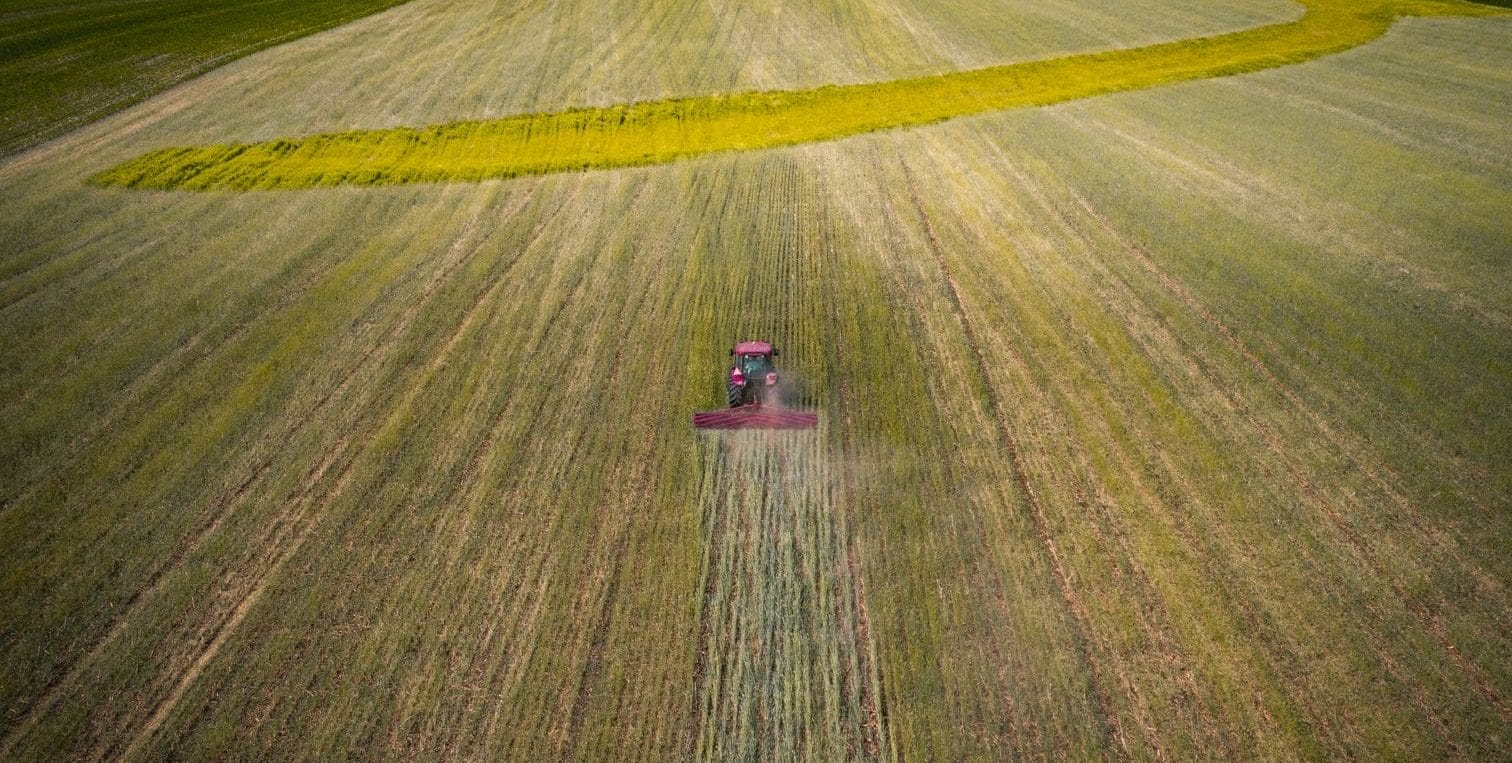
Photo 1: Fred Abels using his roller-crimper to terminate cereal rye when it is at grain-fill stage. Fred’s roller-crimper is close to The Rodale Institute’s original model – a steel barrel with chevron blades that is filled with water to make it heavier. Photo taken June 14, 2023 by Brady Appel.
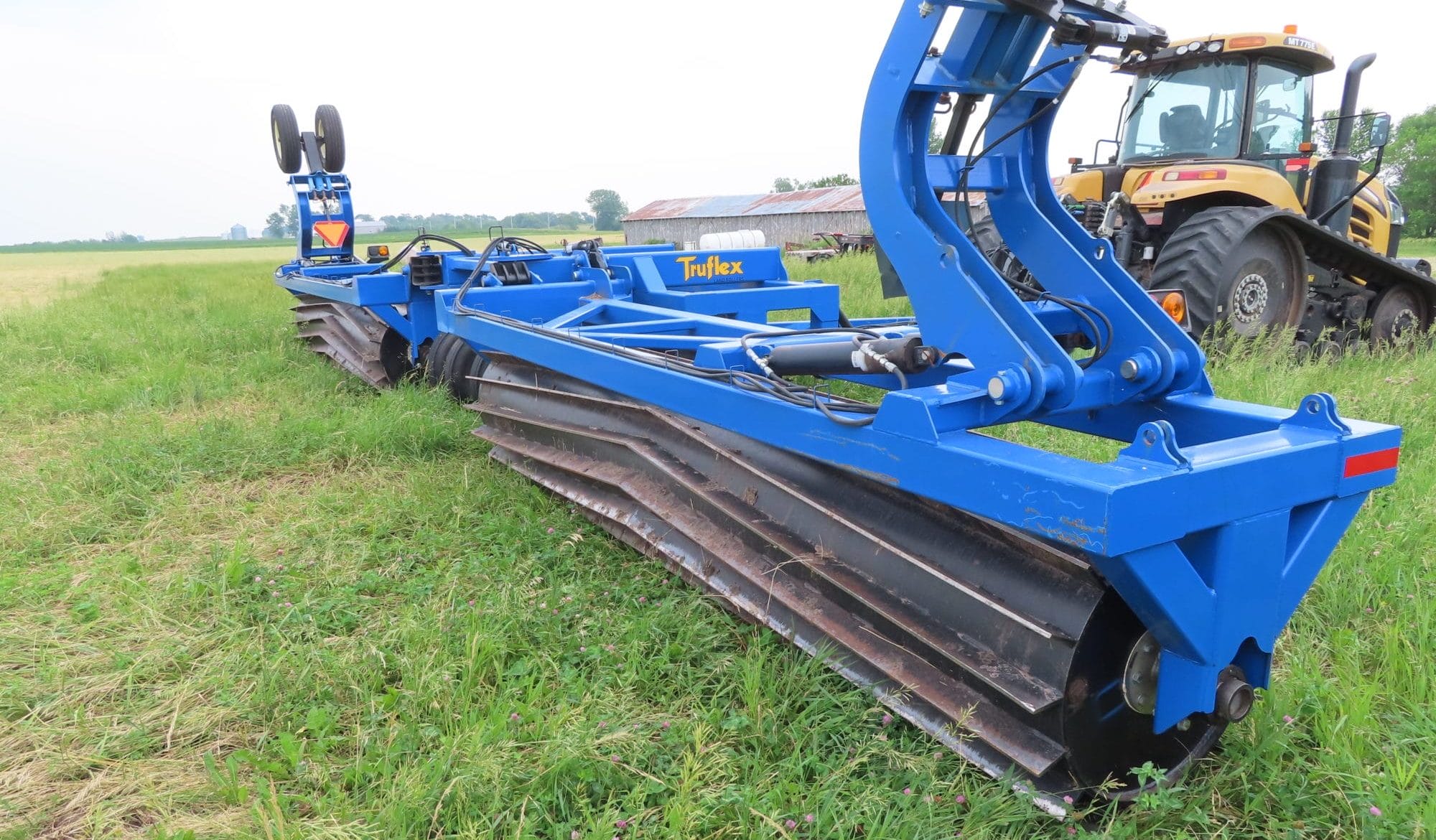
Photo 2: Scott Shriver’s three section Truflex roller-crimper treats a wide area on each pass. Photo taken June 7, 2023.
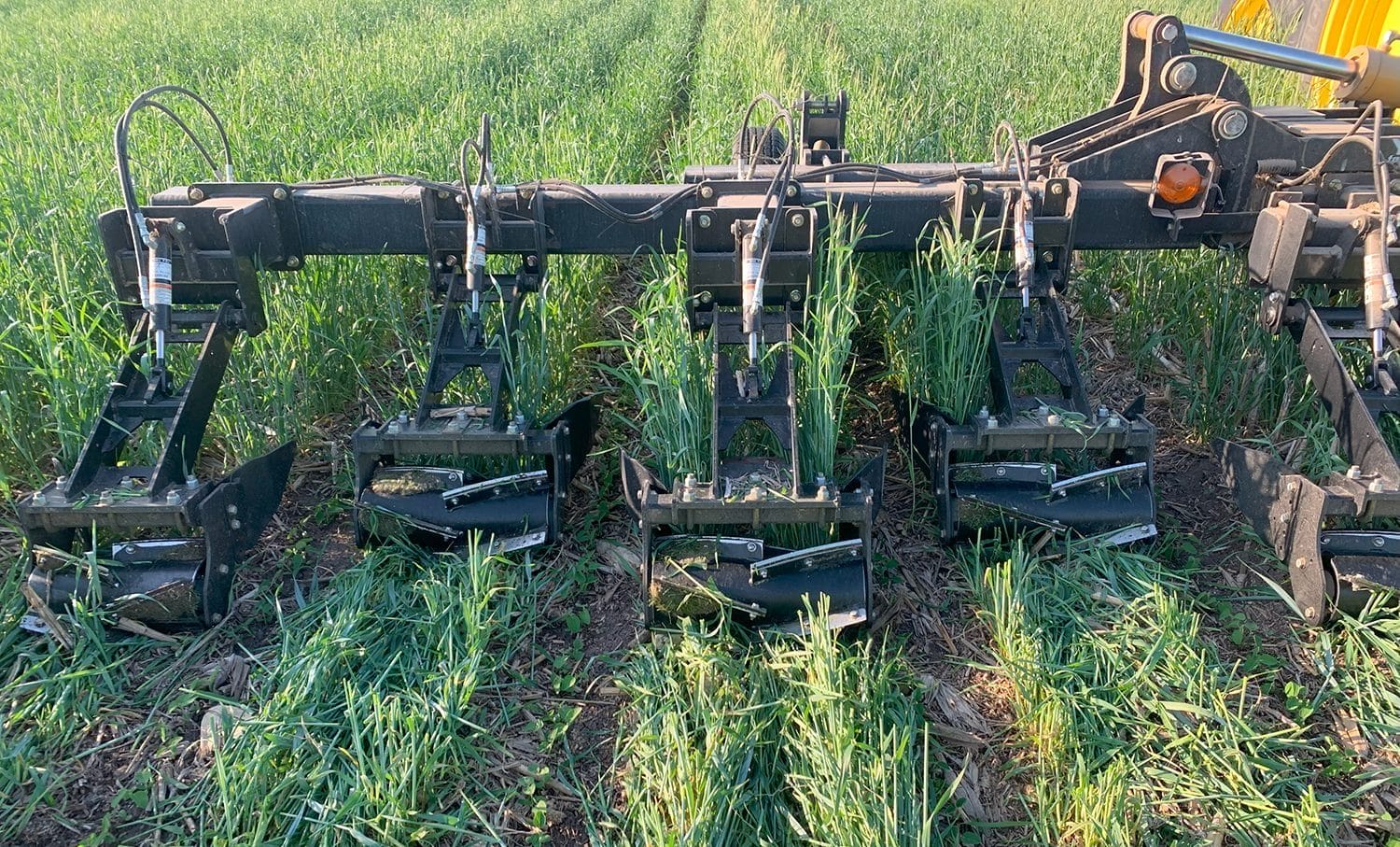
Photo 3: Michael Vittetoe’s in-row roll-crimper in action crimping rye at rye boot stage, about a month after soybean planting, with undisturbed soybean rows in between the rollers. Michael’s roller-crimper, a Dawn ZRX, is a series of small barrels with chevron blades. The barrels are spaced to avoid crop rows. Photo taken May 16, 2023.
Summary of Research Trial Results
Since 2017, PFI cooperators have completed 15 different research trials related to roll-crimping rye in soybean systems. The questions these trials asked fall into two main categories: 1) Does roll-crimping result in soybean yield changes compared to terminating rye with herbicide? (Table 1), and 2) When is the best time to roll-crimp rye or plant soybeans in a roll-crimped system to maximize soybean yield (Table 2)?
All trials followed standard PFI trial design which allows for the use of statistical analysis, except when noted. See Figure A1 at the end for an example trial layout.
Roll-crimping With Herbicide Termination
Many conventional farmers wonder if roll-crimping combined with herbicide works as well as the herbicide they are used to using for no-till cover-cropped soybean production. Cooperators have completed four trials comparing a roll-crimping rye treatment to herbicide-only termination treatments (Table 1).
The results varied between trials; in two cases, roll-crimping or in-row roll-crimping resulted in increased yields, in one trial decreased yields, and in one there was no yield difference between treatments. Individually, these trials have allowed farmers to see what works on their operations and feel more confident in choosing (or not choosing) to use roller-crimpers. For example, Michael Vittetoe notes that his trial confirmed for him that “the in-row roller is an integral part of my future plans for our farm operation.”
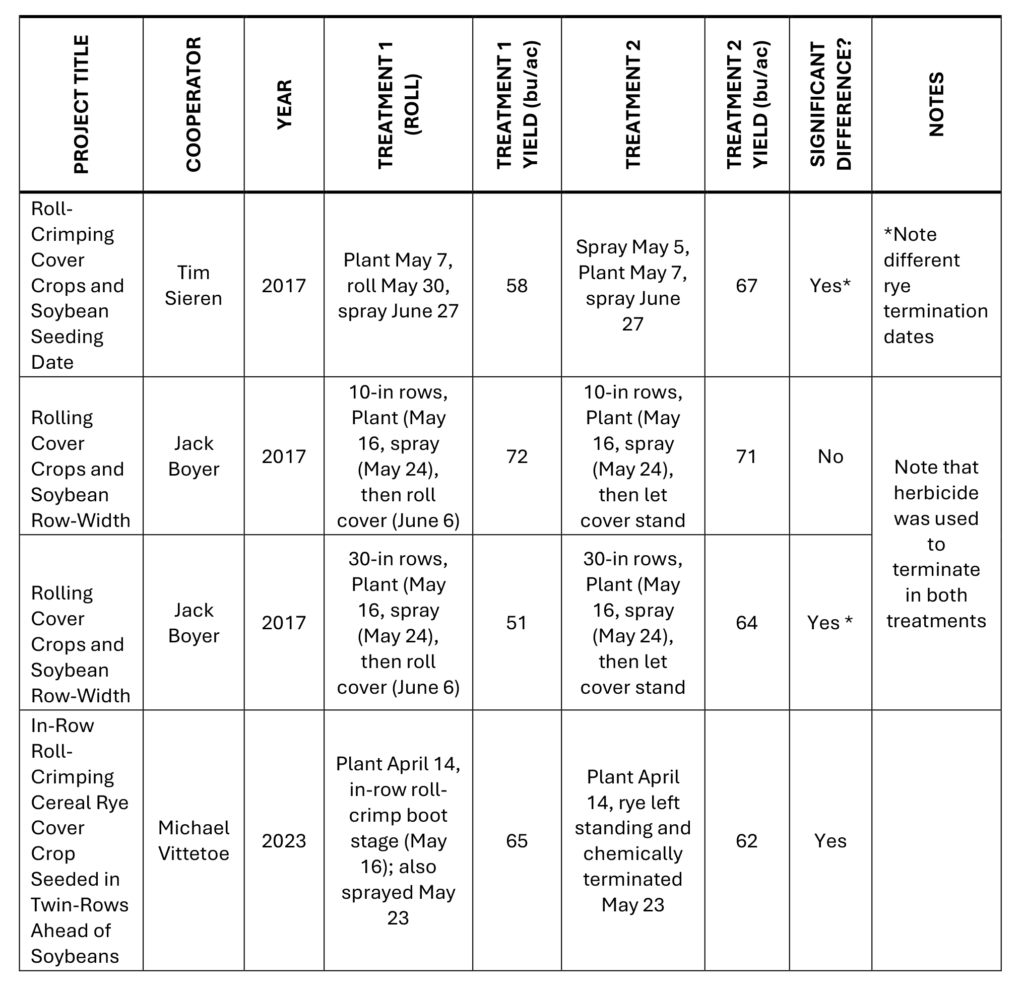
TABLE 1: Treatments and soybean yield results of all cooperator trials testing roll-crimping compared to another termination method of a cereal rye cover crop. Spray = spray herbicide to terminate cereal rye and for weed control.
Termination and Planting Timing When Roll-crimping
If you roll-crimp too early in cereal rye’s growth stage, it might not terminate well because the green stems don’t break or the immature plants are still able to grow new tillers. If you wait too long, soybean yield might be impacted by shade and competition for water and nutrients from the cereal rye.
There are two variables farmers can change to try to strike the perfect balance: when to plant the soybeans and when to crimp the rye. Results were mixed in three trials investigating soybean planting dates; trials by Jon Bakehouse and Tim Sieren both showed that waiting to plant soybeans until late May, when rye is more easily terminated by rolling, results in risk of decreased yields, while a third at Scott Shriver’s showed that planting when rye was roll-crimped in early June resulted in increased yields (Table 2).
In contrast, none of the eight trials on roll-crimping timing in 2023 found that delaying roll-crimping rye for more than a few weeks after soybean planting significantly reduced soybean yields. Many but not all of these trials observed a small (1-2 bu/ac), non-significant reduction in yield with roll-crimping.
It is worth noting that all 2022 and 2023 trials spanned significant drought years, which could have affected the results. It seems that overall, roll-crimping timing within the timeframes these cooperators investigated is probably not going to significantly affect soybean yields.
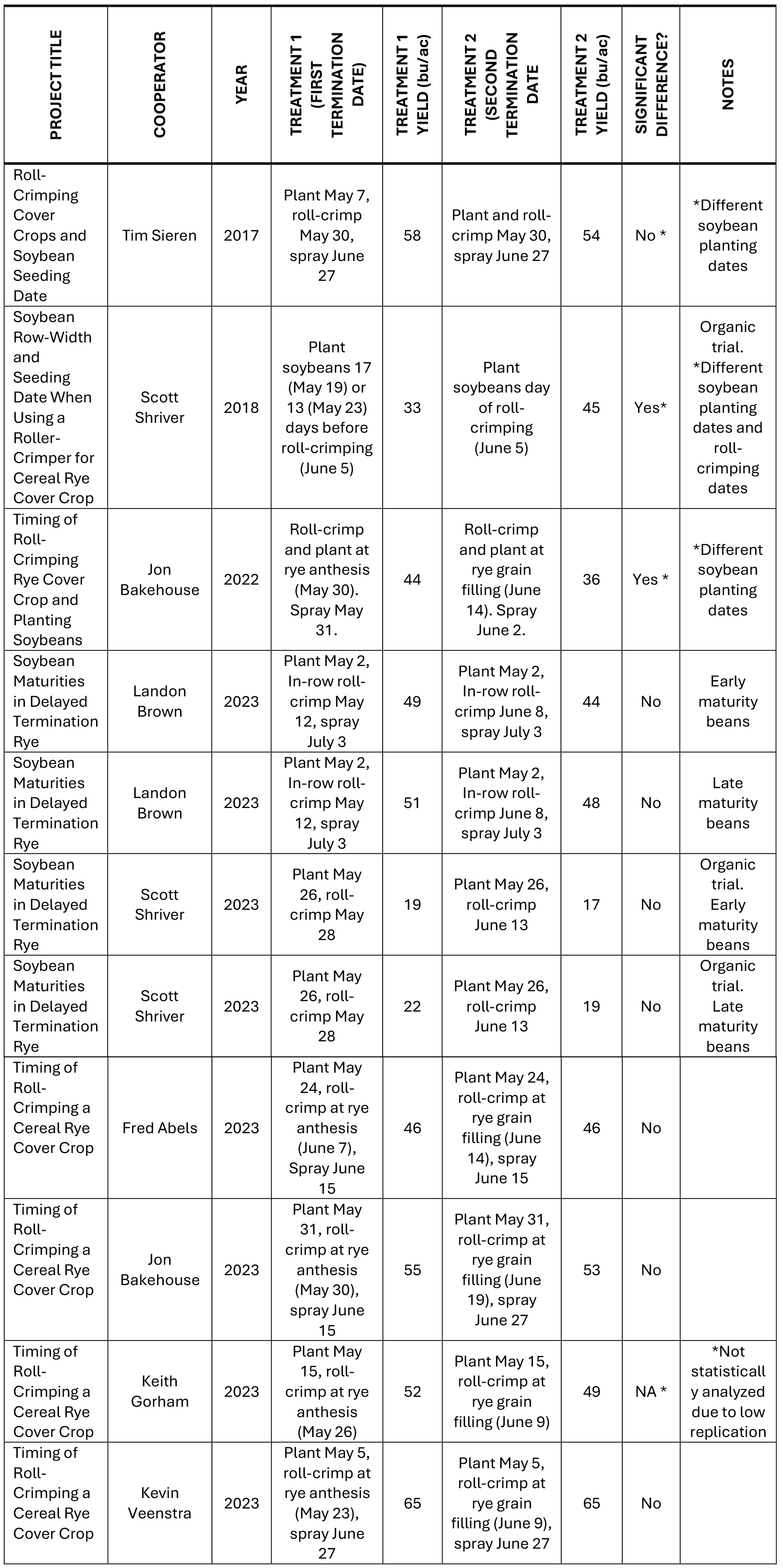
TABLE 2: Treatments and results of all cooperator trials testing timing of planting date or roll-crimping timing in soybean systems. Spray = spray herbicide to terminate cereal rye and/or for weed control. Note that while some conventional farms used herbicide shortly after roll-crimping to help terminate the rye, others (Sieren 2017, Brown 2023, Veenstra 2023) mostly relied on roll-crimping for rye termination and waited until late June or July to apply their first herbicide application.
A Valuable Soil-Covering Tool for Many Toolboxes
As we have seen in the research above, roll-crimping likely doesn’t negatively affect soybean yields in conventional no-till systems where herbicide can be added to complete termination when needed. While it is important to wait until the rye plant is in anthesis or later if you hope to use roll-crimping to terminate it, rolling after anthesis doesn’t require exacting timing to prevent soybean yield loss.
Though it is harder to quantify in on-farm research, one major benefit of roll-crimping is the soil coverage and weed-suppression it brings to both conventional and organic operations. I spoke to Scott Shriver and Jon Bakehouse to get their reflections on how roller-crimpers fit into their operations, and they both emphasized that soil coverage is a unique benefit this practice brings to their system.
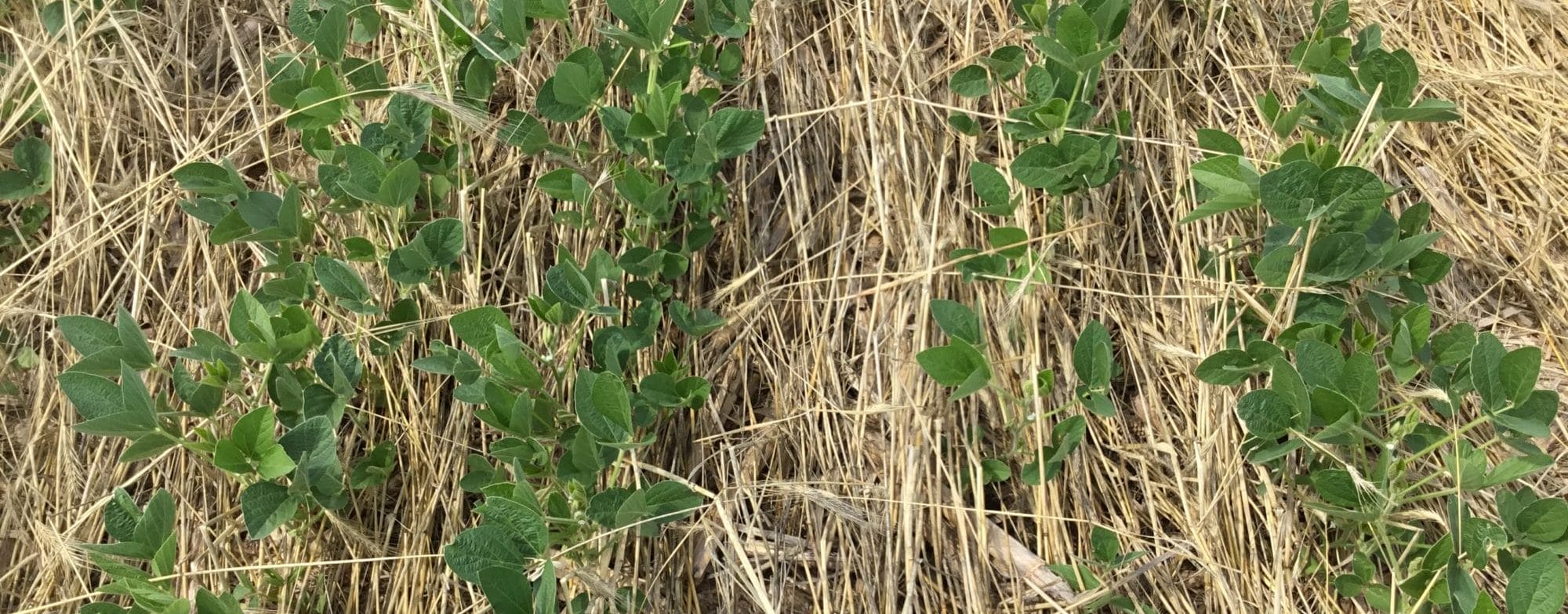
Weed-suppressing rye mat Kevin Veenstra’s 2023 Timing of Roll-Crimping a Cereal Rye Cover Crop trial. Photo taken week of July 14, 2023.
Scott Shriver – Organic
The way Scott Shriver sees it, there are three main factors at play in the success of his organic no-till soybean crop. In order of importance, they are:
- When cereal rye is planted. Planting in September really improves early season weed control and makes no-till production viable.
- How well soybeans are planted. As an organic producer, Scott says achieving sufficient seed depth and coverage when no-till planting into a rye mat has been a learning curve for him.
- Roller-crimper timing. If you go way too early, it won’t crimp. But imperfect crimping can be ok.
Scott says that when his farm first started no-till planting organic soybeans, their main issue was that they were planting the rye too late in the fall to get good ground coverage the following spring. “We were using our standard rotation (corn-soybeans-corn-soybeans-small grain) and trying to plant the rye in early October. We had variable success with weed control; 50% of the time it would be fine, otherwise it would get really bad.”
Scott has since learned that if they plant rye in early-to-mid September, they get much better ground cover and weed suppression from the rye early the next spring. “Foxtail is already in the ground by mid-April – unless you have good coverage then, you have no real chance of weed control by the time you are planting and roll-crimping.”
To get rye planted in September, Scott has had to change crop rotations to a non-standard small grain-soybeans-corn-soybeans-corn, which comes with its own issues but is worth it to him for the ability to consistently successfully grow organic no-till soybeans.
In terms of terminating the rye, Scott says that his farm’s roller-crimping itself still isn’t perfect. They wait to terminate the rye until after the soybeans are up, and still “rarely do we get that picture book look where it rolls flat and stays that way, and we’re getting tillering.” But he notes that he’s not too concerned about this. “As imperfect as it’s been, I don’t think it’s been a problem affecting yield.”
Scott now no-till plants half of his soybeans and manages the rest of his acres with “conventional organic” tillage. “We’re going to continue doing [no-till planting and roller crimping] because, if nothing else, it helps immensely with our labor needs for weed management.” He says that while the no-till soybeans get a slower start and mature about a week later, the yields of the two systems have been comparable.
“[Weed control] can be better in either system if you have the perfect conditions for either system. If I have good opportunities for weed control in the tilled soybeans, they do better. If it rains for two weeks after planting, the roller system will do well.” Splitting his acreage between the two practices gives him some built-in risk mitigation and gives him more time to “do a good job in both systems.”
Jon Bakehouse – Conventional
Jon Bakehouse has been thinking for years about when to plant soybeans and roll-crimp rye to maximize yield in his no-till system. He’s found that for him it’s best to try to roll-crimp rye sometime after anthesis and try to plant soybeans late enough that they are not growing with the rye for longer than a few weeks, but also notes that best laid plans seem to always be thrown out the window by the weather.
This spring, he had two new tools on his belt – a different variety of rye, ND Gardner, that seems to roll much better than the Elbon he used in previous years and a chart demonstrating rye growth stage by Growing Degree Days from Kansas State that helped him track the rye’s growth.
His rye crimped beautifully and provided a great mat for weed control, thanks in large part to ample growth from spring rain. Though in previous years he’s seen soybean growth and yield hits from rye competition, this year he planted his soybeans a bit later and saw that they established well in the wet weather.
Jon doesn’t think that he will ever get full season weed control from rye planted in October, but this year he thinks he will be able to get away with only one herbicide plus residual application in late June. “Reducing to one herbicide application is a great way to combat herbicide resistance and costs,” Jon says.
Roll-crimping also helps build flexibility with the timing of his first herbicide application, which he hires out and can be hard to schedule in the busy early season. In addition to in-season benefits, Jon likes to focus on the extended soil coverage benefits roll-crimping provides. “Roll-crimping is not just for this year but for next year – there is a much better biomass mat for the winter after soybeans, and this way there is 90-100% soil coverage going into the winter. [You gain] protection from the wind and heavy rain, and a beautiful seed bed to plant corn into.”
Additional Resources
Archive of Cooperator’s Program Reports on roller-crimping
PFI videos about cover cropping:
In-Row Roller Crimping for Earlier Soybean Planting
Roller Crimping Cereal Rye in Soybean Production
Shriver Farms – Roll-crimping Cereal Rye
Funding acknowledgement
This material is based upon work supported by the U.S. Department of Agriculture, under agreement number NR226114XXXXG004. Any opinions, findings, conclusions, or recommendations expressed in this publication are those of the author(s) and do not necessarily reflect the views of the U.S. Department of Agriculture. In addition, any reference to specific brands or types of products or services does not constitute or imply an endorsement by the U.S. Department of Agriculture for those products or services.
How do I become a Cooperator?
Contact Emma Link, Senior Research Coordinator, at (515) 232-5661 ext. 1045, or emma.link(at)practicalfarmers(dot)org, to find out how you can become an on-farm research cooperator. To become a cooperator, you first need to join Practical Farmers of Iowa.

